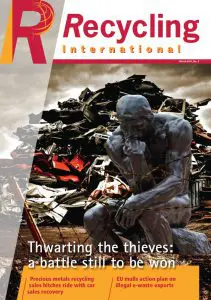Page 8 from: March 2011

8 March 2011
N E W S
The European Food & Safety
Authority (EFSA) has delivered its first
opinion on the safety of a process for
manufacturing recycled plastics to be
used as food-contact materials. The
opinion is in respect of a petition filed
by the Dutch research institute TNO.
Between April 17 2008 and December
31 2009, recyclers of existing process-
es for closed-loop recycling of food-
contact materials both inside and out-
side the EU were obliged to file a
petition at the EFSA to demonstrate
food safety (ie decontamination effi-
ciency for potentially present contami-
nants originating from use or misuse).
EFSA’s first positive opinion related to
a polypropylene RPC crate recycling
operation organised by Dutch firm
Morssinkhof Plastics. The crates
intended for food contact were inves-
tigated by means of the Forest Of Peak
(FOP) analytical approach developed
by TNO which enables a food safety
evaluation of polymer-related degrada-
tion and other unknown chemicals
present in recycled materials.
www.tno.nl
Electric vehicle manufacturer
Tesla Motors has launched a strategy to
recycle its industry-leading battery
packs throughout Europe.
At the end of their useful lives, the
packs will be recycled at Umicore’s UHT
facility in Belgium to produce an alloy
that will be further refined into cobalt,
nickel and other metals. Umicore will
then transform the cobalt into high-
grade lithium-cobalt oxide which can
be resold to battery manufacturers; for
Tesla, this represents not only an attrac-
tive process from an environmental
perspective but also provides a high
margin of return. One of the few by-
products of this approach is a clean,
inertised slag containing calcium oxides
and lithium which will be used in the
production of special-grade concretes.
Umicore’s battery recycling technology
is said to enable the saving of at least
70% of the carbon dioxide emissions in
the recovery and refining of these valu-
able metals, thus substantially reducing
the carbon footprint associated with
manufacturing lithium-ion batteries.
‘While we work to help lessen global
dependence on petroleum-based trans-
portation and drive down the cost of
electric vehicles, we are also taking the
lead in developing a closed-loop battery
recycling system,’ Tesla’s Director of
Energy Storage Systems Kurt Kelty
wrote in a new blog about the process.
‘At Tesla, we have been refining our recy-
cling programme for years. Before send-
ing our battery packs to be recycled, we
can reuse about 10% of the battery pack
(by weight), eg the battery case and some
electronic components. In North Ameri-
ca, we work with Kinsbursky Brothers to
recycle about 60% of the battery pack.
In Europe, we recently started working
with Umicore; and now that we are selling
cars in Japan and the Asia Pacific region,
we will soon have news about recycling in
Asia.’ www.teslamotors.com
Positive response to
TNO plastics petition
Ship recycling facility on US west coast
On February 18 this year, US Maritime Administrator David Matsuda and US
Congressman George Miller cut the ribbon on the first ship recycling facility
on the west coast of the USA. The new Allied Defense Recycling set-up
increases overall US ship recycling capacity and will help expedite the clean-
up of the Suisun Bay Reserve Fleet. At present, there are 50 vessels in the
mothballed fleet and all can be recycled at the new facility, according Jay
Anast, one of the company founders. ‘The Navy spends millions of dollars
and 500 000 gallons of fuel to send those ships to Texas for dismantling,’ he
notes. ‘Why not do it here?’ www.californiadrydock.com
Tesla unveils battery
recycling programme
Japan’s space agency JAXA is
reportedly teaming up with a fishing net
manufacturer to catch and remove
debris from Earth’s orbit where it is cur-
rently posing a threat to spacecraft,
astronauts and satellites. The thin-
metal-wire net would span several
kilometres and be charged with elec-
tricity, allowing the Earth’s magnetic
field to reel in the debris and eventu-
ally burn it up in the planet’s atmo-
sphere, reports UK newspaper ‘The
Telegraph’.
The JAXA concept ‘solves the fuel prob-
lem’, according to experts. ‘You don’t
have to carry fuel on board; you just
have to have a way of generating elec-
tricity, which you can do at those alti-
tudes with solar panels.’
The threat posed by debris to human
operations in space is steadily increas-
ing. Both the International Space Sta-
tion and the Space Shuttle have been
forced to dodge debris in the past. A
collision between a Russian and US
satellite in 2009 is said to have high-
lighted the need for effective ways to
clean up space.
The Secure World Foundation’s report
entitled Space Security 2010 identified
space debris as a top concern. Cur-
rently, the US military is tracking 21 000
known objects larger than 10 centime-
tres in the Earth’s orbit; of these, only
around 1000 are working satellites
whereas the remainder are either dead
satellites, rocket parts or other pieces
of space junk. However, all are large
enough to destroy whatever they hit.
Other ideas for clearing the junk include
spacecraft attaching themselves to
debris and then de-orbiting it into the
Earth’s atmosphere with the aid, for
example, of a solar sail. www.jaxa.jp
Japan to go fishing …
for space debris
The new facility will recycle mothballed
Marad vessels.
p08_NEWS.indd 8 01-03-11 14:45



